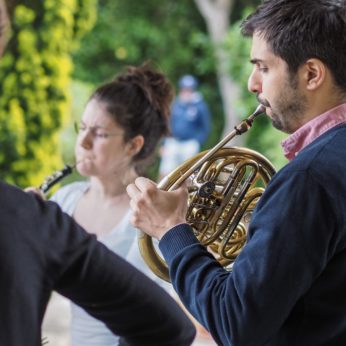Composer: Jacques Ibert (b. 1890 - d. 1962)
Performance date: 05/07/2019
Venue: St. Brendan’s Church
Composition Year: 1930
Duration: 00:08:06
Recording Engineer: Gar Duffy, RTÉ
Instrumentation Category:Wind Quintet
Artists:
Azahar Wind Quintet (Frederic Sanchez Muñoz [flute], María Alba Carmona Tobella [oboe], Miguel Ramos Salvadó [clarinet], Antonio Lageres Abeal [horn], María José García Zamora [bassoon]) -
[wind quintet]

Azahar Ensemble
Frederic Sanchez Muñoz [flute], María Alba Carmona Tobella [oboe]
Miquel Ramos Salvadó [clarinet], Antonio Lagares Abeal [horn]
María José García Zamora [bassoon]
Jacques Ibert [1890-1962]
Trois Pièces Brèves [1930]
As a teenager Ibert began his public career by playing music to accompany silent films in cinemas. He went on to compose film and theatre music throughout his life. It is not surprising therefore that he felt extremely comfortable composing the kind of charming, witty music we find in these Trois Pieces. What is perhaps more surprising is the extraordinary skill and sophistication he devotes to music which nowadays might be dismissed as “easy listening”.
Ibert’s work in cinemas helped pay for his studies at the Paris Conservatoire which were interrupted by the First World War. He served with distinction in both the Army and the Navy and was awarded the Croix de Guerre. On returning to Paris, he astonishingly won the prestigious Prix de Rome for composition in 1919 at the first attempt. Great composers struggled to win this prize. It took Debussy three attempts finally winning in 1885. Ravel never won the Prize even after five attempts.
Ibert was eclectic in his musical tastes. He loved and was influenced by the music of Debussy, Stravinsky and Bartók. There seems to be no modern composer he did not enjoy. He claimed to love Wagner as much as Schoenberg (there may be some irony here). His compositions were never properly atonal favouring traditional key relationships and 9th, 11th and 13th intervals. He tended to write in the neo-classical style which, although modern in its harmonies, nevertheless recognised a debt to eighteenth century music. This style had been developed by Debussy shortly before his death in 1918 and then taken up by Stravinsky and many others in the 1920s.
The “Trois Pièces Brèves” date from 1930. The disasters of the 1930s did not arrive in France until 1931 and in these fabulous miniatures, the party spirit of the 1920s certainly lives on. The introduction to the first Pièce has a distinct flavour of Stravinsky. But not for long. Utter gaiety takes over with a main tune that could be a hornpipe. There is a brief development and a crazy coda.
The second Pièce, serving as a slow movement, mainly consists of a beautiful plaintive duet between flute and clarinet. The finale (the third Piece) begins with a slow introduction before a delightful theme based on a rising arpeggio takes over. This is owned by the clarinet but, in the fun that follows, is wittily borrowed by the bassoon. This music may not be serious but it is not trivial or vapid. It is superbly crafted and completely delightful.
David Winter
Copyright © 2025 West Cork Music. All rights reserved.
Designed and developed by Matrix Internet